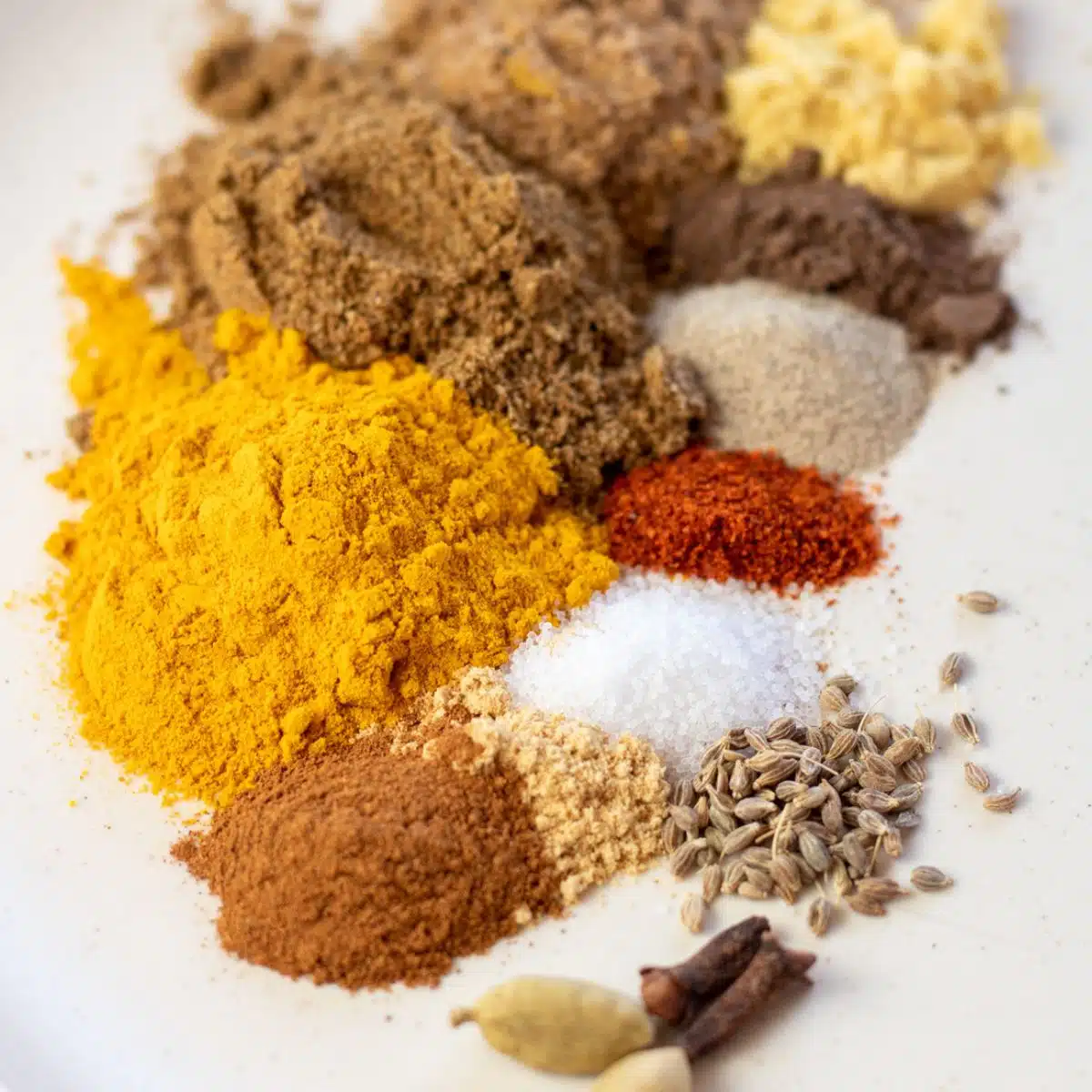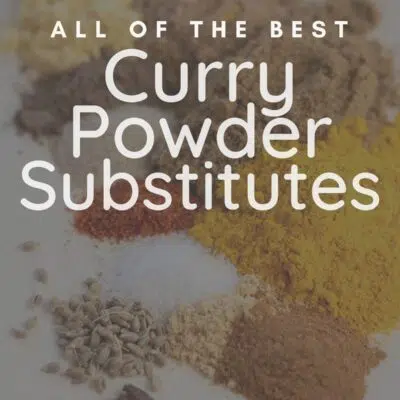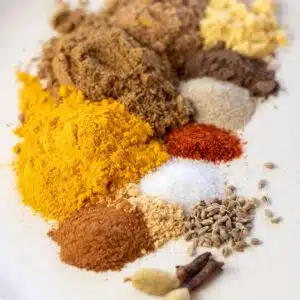If you need a curry powder substitute, I have gathered the best spices and spice blends to mimic its unique flavor, color, or both! Curry powder can be fused in everything from sauces and marinades to meat seasonings and vegetables. Knowing how to substitute for curry powder in a pinch will definitely come in handy!
Easy Curry Powder Substitutes
Curry Powder is a wonderful spice blend that is popularly known for its yellow coloring. While it is commonly thought to be a staple ingredient in Indian cooking, it was actually created by the British.
It was the result of the British wanting to bring common flavors they had experienced in Indian cooking into their recipes. Therefore, they created a blend using several spices commonly seen in Indian cooking.

Jump to:
- Easy Curry Powder Substitutes
- What Spices Are Used in Curry Powder?
- 1. Homemade Yellow Curry Powder
- Other Curry Powder Alternatives
- 2. Cumin + Allspice
- 3. Chili Powder + Cumin
- 4. Turmeric + Cumin
- 5. All Spice + Chili Powder + Turmeric
- 6. Turmeric + Coriander + All Spice
- 7. All Spice
- 8. Curry Paste
- Other Spice Blend Substitutes for Curry Powder
- 9. Garam Masala
- 10. Chaat Masala
- 11. Tandoori Masala
- 12. Sambar Powder
- 13. Chinese 5 Spice
- 📖 Recipe Card
- 💬 Reviews
This pre-made blend of spices is used to make many different dishes that are now referred to as “curry.” However, it is not used in making traditional curries that you may find in an Indian or Thai restaurant.
Red, green, and yellow Thai and Indian curry uses many of the spices used in curry powder. Some chefs even have them pre-blended. They are different than the yellow curry powder your recipe calls for.
What Spices Are Used in Curry Powder?
The curry powder your recipe calls for is a yellow powder with warm flavors and aromas. The perfect addition to soups, stews, and sauces that pairs well with meat, poultry, fish, grains, and vegetables!
While curry powder can vary depending on who is making it, there are some standard spices. Knowing what standard spices are used will help you know what types of spices you can use as a substitute.
Common spices found in curry powder are turmeric, cumin, chili powder, ginger powder, pepper, fenugreek, and sometimes curry leaf.
1. Homemade Yellow Curry Powder
If you don’t have a pre-made curry powder, you may have all the seasonings you need to make your own! Here is my favorite recipe for homemade yellow curry powder.
- 1 teaspoon of Cumin
- 1 teaspoon Coriander
- 2 teaspoons Ground Turmeric
- ½ teaspoon Ground Ginger
- ¼ teaspoon Cardamon
- ¼ teaspoon Ground White Pepper
- ½ teaspoon Dry Mustard
- ¼ teaspoon Nutmeg (or mace)
- ¼ teaspoon Ground Clove
- 1 pinch of Cayenne Pepper
- ¼ teaspoon Cinnamon
- 1 pinch of Salt
Simply add all these spices to a bowl and stir together. Simple as that! If you are missing one or two of the ingredients listed above, check out my full recipe to see if there is a substitute you can use.
If you only have a few of these spices at home right now, keep reading to see how you can use these spices in other pairings (or on their own) as a substitute.
Other Curry Powder Alternatives
If you don’t have all the spices on hand to make a complete curry powder, you can still use the spices you do have as a substitute. As seen above, curry powder is a complex blend of several flavors. Therefore, you will get the closest substitute when using multiple spices.
Peak in your cabinet and see what you have available. If you only have one of the main spices used to make curry powder, you may be able to use it in a pinch. However, you may want to look for a different spice blend.
2. Cumin + Allspice
Cumin and Allspice are a good blend that offers both the warmth and sweetness of curry powder. It will be a simpler flavor profile than curry but is still a great substitute for chicken dishes, soups, and sauces.
Mix equal amounts of both cumin and allspice. 1 ¼ teaspoon of the cumin/allspice blend = 1 teaspoon of curry powder.
3. Chili Powder + Cumin
If you want to focus on a spicier flavor for your recipe, then use a blend of Chili Powder and Cumin. This blend will be savory and with a strong pungent flavor.
Mix half Chili Powder and half Cumin to equal one part curry powder: ½ teaspoon Chili Powder + ½ teaspoon Cumin = 1 teaspoon curry powder.
4. Turmeric + Cumin
For recipes that need the rich yellow color of curry then you need to use turmeric. Turmeric is where the bright yellow color comes from in curry.
While turmeric lends a bold color to any dish, it does not lend a bold flavor. Compared to other spices turmeric is quite subdued in flavor. Therefore, to get both color and flavor combine it with cumin.
Begin with a ½ and ½ blend of turmeric and cumin (½ teaspoon turmeric + ½ teaspoon cumin = 1 teaspoon curry powder). If the flavor (or color) is not strong enough then slowly add more of either (or both) seasonings.
5. All Spice + Chili Powder + Turmeric
Three flavors are better than one (or none) when trying to replace the complex flavors found in curry. All Spice offers warmth. Chili Powder offers spice. Turmeric offers a bitter balance between the two.
Moreover, turmeric provides a golden yellow color to make your dish look like curry.
Mix ½ teaspoon of Chili Powder + ½ teaspoon of Turmeric + ¼ teaspoon of All Spice to replace 1 teaspoon of curry powder.
6. Turmeric + Coriander + All Spice
If you don’t have cumin, see if you have some coriander in your spice cabinet. Coriander (or coriander seeds) have a pungent and earthy taste. Coriander can be used in the same way cumin is used to bring out the astringent flavors of your recipe.
Combined with All Spice and Turmeric brings in warmth, balances the pungency, and adds color.
Mix ½ teaspoon of Coriander Powder + ½ teaspoon of Turmeric + ¼ teaspoon of All Spice to replace 1 teaspoon of curry powder.
7. All Spice
In a pinch, you can use a small amount of All Spice on its own. It will provide a warm and aromatic hint of flavor. It will not be as complex as curry powder though. Moreover, too much of All Spice on its own can be overpowering.
Use only a ¼ amount of All Spice in place of curry powder: ¼ teaspoon All Spice = 1 teaspoon curry powder.
8. Curry Paste
If you are standing in the aisle at the grocery store looking for a substitute because the store is out of curry powder – look for curry paste. This is the closest flavor replacement for curry powder.
The rich flavor of this substitute is wonderful for maintaining a strong curry flavor in curry sauces, soups, and stews. It also works best in these recipes since it needs to be diluted.
Curry paste is a concentrated version of curry powder. Therefore, it needs to be diluted before use so it doesn’t overpower your recipe.
Use curry paste in a 1:1 ratio for curry powder. Before using, mix with 1 part water.
1 tablespoon of curry paste + 1 tablespoon of water = 1 tablespoon curry powder.
Other Spice Blend Substitutes for Curry Powder
There are several different spice blends from around the world. Each has its own distinct flavor.
While these different blends will impart their own unique flavor profile to a recipe, they will provide a wonderfully rich flavor profile. Therefore, they are great substitutes for curry powder when you want a complex flavor (even if it is slightly different)
9. Garam Masala
Garam Masala is a Southeast Asian spice blend. It uses some of the same spices that are found in curry powder, such as cumin, coriander, and cardamom. It also includes cinnamon, cloves, bay leaf, fennel, and peppercorn.
Garam Masala has a flavor with a bit more punch than curry powder, but it can still be used in a 1:1 substitution. It adds a rich flavor to chicken dishes and soups and stews.
10. Chaat Masala
Chaat Masala is not as commonly found in grocery stores as Garam Masala. If you have access to it though you can use it as a substitute for curry powder.
It has a sweeter and stronger flavor than curry (and Garam Masala) but pairs nicely with many of the same foods. Use it in a 1:1 substitution in soups, sauces, and marinades that you want to have a sweet and savory flavor.
11. Tandoori Masala
If you are a fan of Tandoori Chicken, then you are already familiar with Tandoori Masala. This spice blend typically includes coriander, cumin, garlic powder, ginger, cloves, mace, fenugreek, cinnamon, black pepper, cardamom, and nutmeg.
While it shares many spices with curry powder there is also the addition of several other spices. The addition of these other spices creates a more pungent flavor than curry. It also creates a reddish-orange color.
Use ½ the amount of Tandoori Masala in place of curry powder. If you feel the flavor is not strong enough, you can slowly add more as desired.
12. Sambar Powder
Sambar Powder is a blend of spices used in South India. It includes coriander seeds, cumin seeds, mustard seeds, peppercorns, red chiles, fenugreek, and cinnamon.
Like Masala spice blends, it has a similar flavor profile to curry but with a stronger overall flavor. In fact, it is even more pungent than other Masala blends. Therefore, it is best paired with other strong flavors, such as red meat and fish.
Use half the amount the recipe calls for in curry powder (½ teaspoon sambar powder = 1 teaspoon curry powder).
13. Chinese 5 Spice
Chinese 5 Spice is a spice blend that has its own unique flavor. In contrast to the warmth of curry powder, it is more bitter and sour. It also has sweet and salty notes.
The complex flavor profile of this spice blend is wonderful for bringing a full-bodied flavor to a recipe. Therefore, while it is quite different than the typical flavors of curry powder it can be a fun flavor exchange.
Start with half the amount of Chinese 5 Spice in place of curry powder. You can always add more (if desired) once you do a taste test.
The perfect curry powder substitute may be as close as your spice cabinet! Try it in your favorite recipes and let us know how they turn out!
Do you love a recipe you tried? Please leave a 5-star 🌟rating in the recipe card below and/or a review in the comments section further down the page.
Stay in touch with me through social media @ Pinterest, Facebook, Instagram, or Twitter! Subscribe to the newsletter today (no spam, I promise)! Don't forget to tag me when you try one of my recipes!
📖 Recipe Card
Curry Powder Substitute: DIY Yellow Curry Powder (+More Great Alternatives!)
Ingredients
- 2 teaspoon cumin
- 1 teaspoon ground coriander
- 1 teaspoon ground turmeric
- ¼ teaspoon ground ginger
- ¼ teaspoon dry mustard powder
- ¼ teaspoon cinnamon
- ¼ teaspoon ground cardamom
- ¼ teaspoon ground white pepper (or black pepper)
- ¼ teaspoon ground nutmeg (or allspice or mace)
- ¼ teaspoon ground clove
- 1 pinch ground cayenne pepper
- 1 pinch salt
Optional
- ¼ teaspoon fenugreek seed (ground)
- ¼ teaspoon fennel seed (or anise seed, ground)
(Note: 2x or 3x only changes the ingredient list)
Instructions
- If you are using any whole seeds, grind them up before adding to the mix. *Optionally, you may toast whole seeds before grinding (*see note).
- Place all ground spices in an airtight container or jar with a lid and shake to combine.
- Keep your yellow curry powder in the same airtight container or jar with lid for up to 12 months. Shake before using to redistribute the spices.
Notes
- Toast whole seeds in a dry skillet over medium heat until toasted and fragrant then immediately remove from heat and transfer out of the hot skillet.
- 1-2 whole cloves and 1-2 cardamom pods can be used to replace ground cloves or cardamom, be sure to grind them before adding.
- If you are using ground spices that are past their prime, lightly toasting them in a skillet over medium-high heat for 35-45 seconds can refresh their flavor.



Comments
No Comments